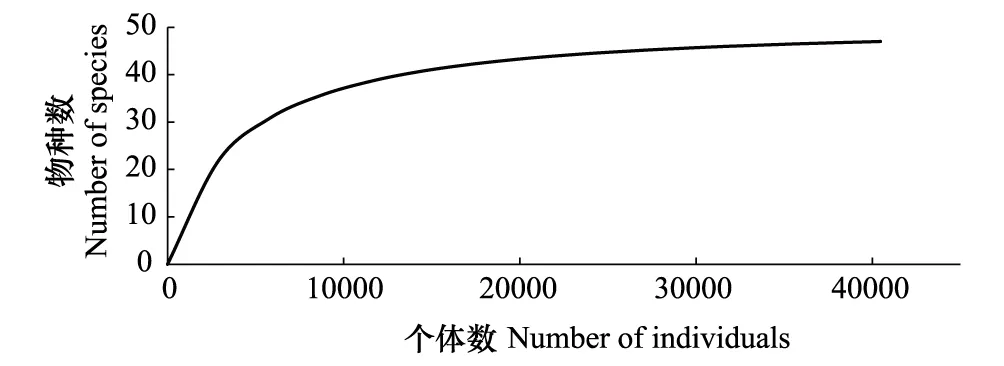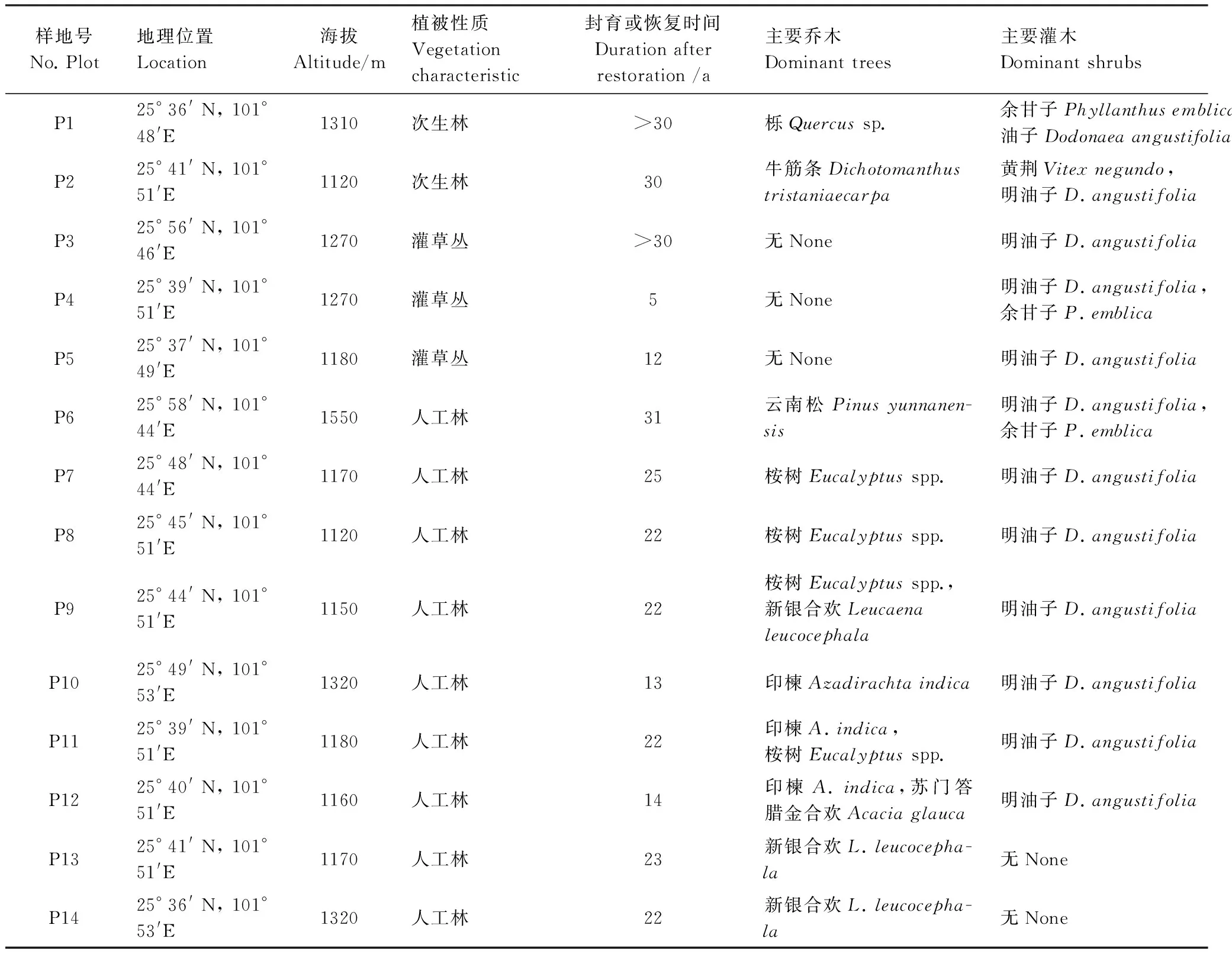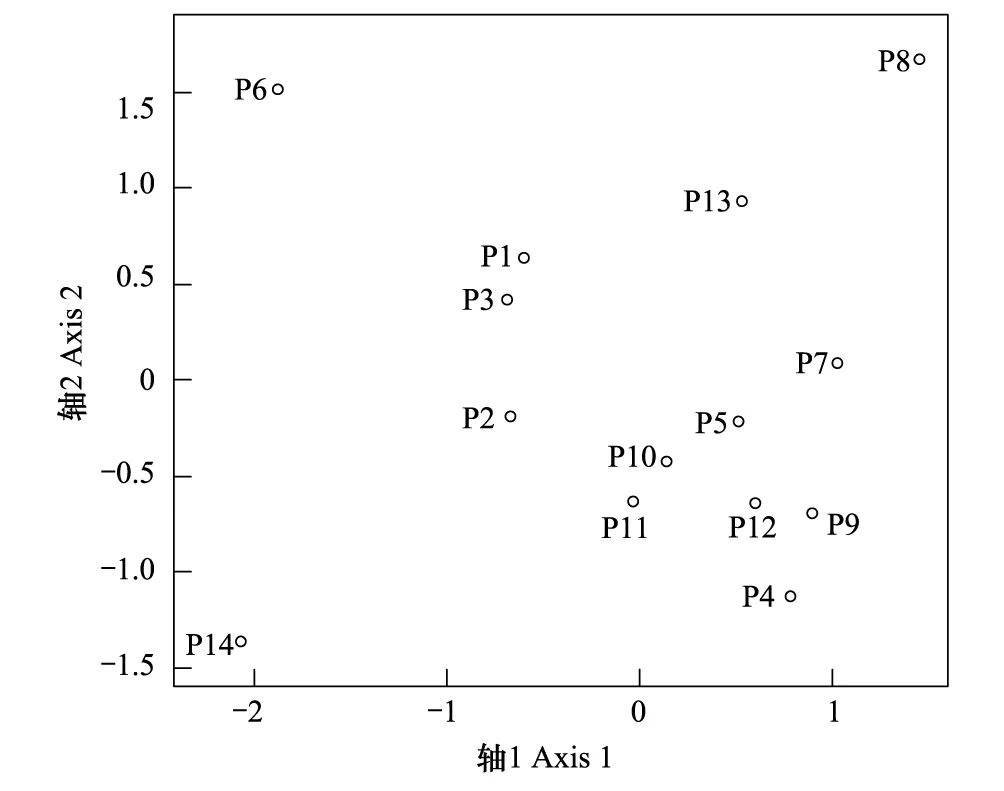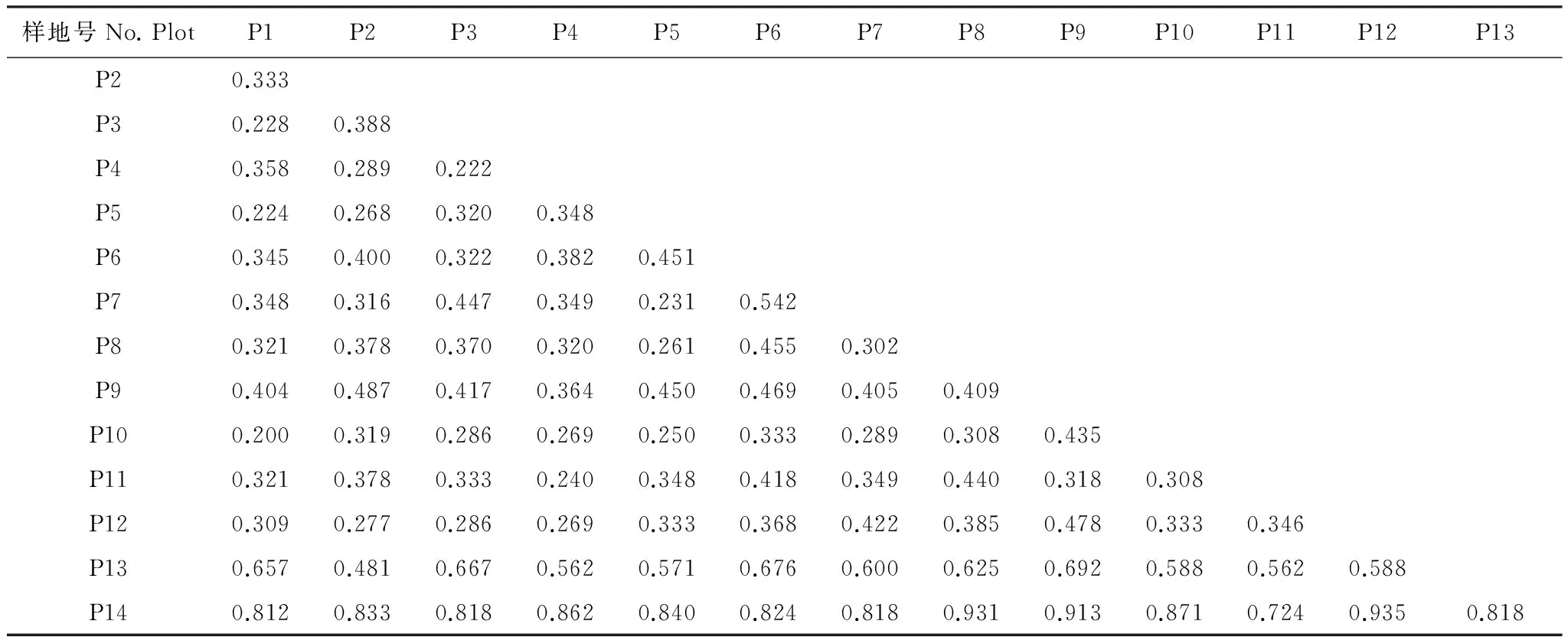地表蚂蚁在云南萨王纳地区植被恢复过程中的指示作用
2015-01-19卢志兴马艳滟
李 巧, 卢志兴, 张 威, 马艳滟, 冯 萍
西南林业大学云南省森林灾害预警与控制重点实验室, 昆明 650224
地表蚂蚁在云南萨王纳地区植被恢复过程中的指示作用
李 巧*, 卢志兴, 张 威, 马艳滟, 冯 萍
西南林业大学云南省森林灾害预警与控制重点实验室, 昆明 650224
为了查清地表蚂蚁在萨王纳地区人工植被恢复过程中的指示作用,采用陷阱法调查了云南省萨王纳地区人工林和自然植被地表蚂蚁多样性。(1) 群落物种组成:采集蚂蚁40467 头,隶属于5 亚科19 属47 种。扁平虹臭蚁Iridomyrmesanceps是保护较好自然植被的常见种;而迈氏小家蚁Monomoriummayri是干扰较大的自然植被及多数人工林的常见种。(2)多度和α多样性:在人工林中,印楝林地表蚂蚁群落多度和α多样性最高,桉树林次之,新银合欢林最低。(3)群落相似性及β多样性:印楝林地表蚂蚁群落与自然植被灌草丛较接近,而其它人工林蚂蚁物种组成不相似;新银合欢林β多样性最高,βCs值在0.481—0.935;印楝林较低,βCs值在0.200—0.478。(4)相关性分析:地表蚂蚁群落物种丰富度S值及ACE值和草本植物群落S值及ACE值均正相关。印楝林和桉树林具有较高的α多样性,在当地生物多样性保护中具有积极意义;而新银合欢林是生境极度退化区域的重要植被恢复模式之一,这3种人工林对于萨王纳地区植被恢复具有重要作用。蚂蚁群落α多样性能够作为生物多样性的指示物,指示云南萨王纳地区植被恢复中生物多样性的状况。
蚁科; 生物多样性; 物种组成; 生物指示; 人工林
萨王纳也称稀树草原,主要分布在气候炎热干旱、土壤浅薄贫瘠、森林不易生长的地区,是热带和亚热带最常见的植被类型之一,大约1/5的世界人口居住在萨王纳植被区,其中许多人还处于依赖畜牧或温饱型农业的农村社会[1-2]。中国云南萨王纳属于河谷型萨王纳,位于云南省境内横断山区干旱及半干旱河谷地带,主要分布在金沙江、怒江、澜沧江及元江的中游等河谷区[3-4]。不同地区萨王纳的代表性植物不同:非洲萨王纳是以金合欢属(Acaciaspp.)为优势,而南美洲亚马逊南部和北部则以Brysonimaspp.和Curatellaspp.为优势[5],云南萨王纳以明油子(Dodonaeaangustifolia)和余甘子(Phyllanthusemblica)最为常见[6-7]。
云南萨王纳地区的生态环境处于强度脆弱状态[8]。营造人工林是植被恢复的重要途径,人工林能够为一些受威胁或濒危的物种提供栖境,为生物多样性保护作出贡献[9]。世界范围内人工林的面积约为1.4×108hm2,而中国人工林面积居世界之首,为3.14×107hm2,主要造林树种多为本土种如松树(Pinusspp.);外来树种中桉树林种植面积约1.3×106hm2[10]。自20世纪60年代以来,云南萨王纳地区开始了较大规模的植被恢复实践,以乡土树种如云南松(Pinusyunnanensis)进行大面积飞播造林;到80—90年代,外来树种如桉树(Eucalyptusspp.)、新银合欢(Leucaenaleucocephala)、印楝(Azadirachtaindica)、相思(Acaciaspp.)等成为主要造林树种[11-12]。
在云南萨王纳地区,生物多样性研究屡见报道,多以植被或分类单元为研究对象[13-15],鲜有对不同人工林生物多样性及恢复状况评价的研究。
蚂蚁是地球上分布最广泛、种类和数量最多的社会性昆虫,其易于采集,多度和多样性高、在所有营养级水平上生态重要性高,对生态变化敏感,蚂蚁群落中约1/3的物种对干扰具有明显反应,因此蚂蚁物种组成常被用来评价干扰对蚂蚁群落的影响;在世界范围内,蚂蚁是使用最广泛的指示生物,许多学者运用其多样性指示生境的生物多样性状况[16-18]。
本文以云南萨王纳地区人工林及自然植被地表蚂蚁作为研究对象,通过比较人工林地表蚂蚁群落物种组成及多样性与自然植被的异同,揭示不同人工林生物多样性状况,以及各人工林对当地生物多样性保护的意义,为云南萨王纳地区的植被恢复和生物多样性保护提供参考。
1 研究地概况
研究地区位于云南省元谋县境内,根据不同植被类型设置调查样地,各样地的情况见表1。
2 研究方法
2.1 地表蚂蚁群落调查
运用陷阱法进行地表蚂蚁群落抽样调查[19]。以口径8 cm、高15 cm的塑料杯作为陷阱,在每个调查样地内设置陷阱10 个,分别采用国际通用的陷阱溶液乙二醇和国内常用的陷阱溶液糖醋液作为本研究的陷阱溶液,陷阱分为2 组:第1 组以50 mL乙二醇作为陷阱溶液;第2 组以80 mL糖醋液作为陷阱溶液[14];同组陷阱间距10 m,2 组间相距20 m;每个陷阱上方放置防雨的石板。陷阱放置时间为5 d。于2005年3—11月每2 个月调查1次,共调查5 次。2011年4月和8月对人工林中桉树林和印楝林进行再次调查。采集到的标本用75%酒精保存,带回实验室整理、鉴定种类、记录数量。
2.2 数据分析

图1 云南萨王纳地区地表蚂蚁群落物种累积曲线 Fig.1 Species accumulation curves of ground-dwelling ant communities in savana area, Yunnan
各样地10 个陷阱作为1 个样本,将5 次调查的数据合并后进行统计分析。(1)抽样充分性,利用EstimateS(Version 8.2.0)软件[20]计算物种累积曲线,并通过Excel完成曲线的绘制[21-22];运用基于多度的物种丰富度估计值(ACE)方法对各样地蚂蚁物种丰富度进行估计,比较物种丰富度S值(物种数实测值)与ACE值的相对大小[23-24];结合以上两种方式进行抽样充分性判断;(2)群落物种组成,根据调查及鉴定结果分析云南萨王纳地区地表蚂蚁群落在亚科及属级单元的组成,以及不同人工林常见种的组成[22,24];(3)多度和α多样性,采用地表蚂蚁个体数、物种丰富度S值及ACE值来度量各调查样地地表蚂蚁多度及α多样性[25-26];利用EstimateS(Version 8.2.0)软件完成ACE值的计算[20],利用SPSS中的One-way ANOVA对不同地表蚂蚁群落组成进行方差分析(方差分析前进行等方差及正态分布的判断);(4)群落相似性及β多样性,运用R语言统计软件labdsv软件包中的非度量多位尺度分析方法(nMDS),对各样地蚂蚁群落的物种组成相似性进行比较[27-28],分析不同人工林地表蚂蚁群落的组成特点;利用βCs=1-Cs公式进行β多样性计算[29-30],利用EstimateS(Version 8.2.0)软件完成Sørensen相似性指数Cs值的计算[20]; (5)相关性分析,利用SPSS软件中的Correlation对地表蚂蚁多样性和植物多样性(植物多样性数据为未发表数据)进行相关性分析[17]。除特别指出外,文中数据均为2005年的调查数据。
3 结果与分析
3.1 抽样充分性
云南萨王纳地区不同植被地表蚂蚁群落物种累积曲线见图1。云南萨王纳地区地表蚂蚁群落物种累积曲线为一渐进线,急剧上升后趋于平缓;物种丰富度实测值S值与ACE估计值均为47,S/ACE=100%;因此,此次研究中抽样量充分。
3.2 群落物种组成
在云南萨王纳地区共采集地表蚂蚁40467 头,隶属于5 亚科19 属47 种。在5个亚科中,属最丰富的是蚁亚科Formicinae,有6 属,其次是切叶蚁亚科Myrmicinae和臭蚁亚科Dolichoderinae,均为5 属;种最丰富的是切叶蚁亚科,有19 种,其次是蚁亚科,有17 种。在属级单元中,种类最丰富的是铺道蚁属Tetramorium和弓背蚁属Camponotus,均为6 种;其次是小家蚁属Monomorium和立毛蚁属Paratrechina,均为5 种。

表1 云南萨王纳地区调查样地基本概况
各样地地表蚂蚁群落常见种组成见表2。保护相对较好的自然植被中,扁平虹臭蚁Iridomyrmesanceps十分常见;而干扰较大的自然植被及多数人工林则是迈氏小家蚁Monomoriummayri占据数量优势。
3.3 多度和α多样性
云南萨王纳地区各样地地表蚂蚁群落多度和α多样性见表3。自然植被中,地表蚂蚁群落多度最高的是P4,最低的是P3;而物种丰富度S值和ACE值都显示出P2多样性最低。人工植被中,P6(云南松林)地表蚂蚁群落多度和α多样性最高,P13和14则最低。

表2 云南萨王纳地区地表蚂蚁群落常见种

表3 云南萨王纳地区地表蚂蚁群落多度和α多样性
根据植被组成的不同,对自然植被中的次生林和灌草丛,人工植被中的桉树林、印楝林和新银合欢林地表蚂蚁群落多度和α多样性进行方差分析和多重比较(表4)。在自然植被的次生林和灌草丛地表蚂蚁群落中,无论是个体数还是物种数S值及ACE值,均无显著性差异,显示出灌草丛具有和次生林一致的地表蚂蚁多度和α多样性水平。在人工植被中,印楝林地表蚂蚁群落多度和α多样性最高,与自然植被地表蚂蚁群落的多度和α多样性水平一致;桉树林次之,其地表蚂蚁群落多度和α多样性与自然植被无显著差异,仅是ACE值显著低于自然植被中的灌草丛。而新银合欢林具有极低的地表蚂蚁多度和α多样性,显著低于其它植被。
2011年对桉树林、印楝纯林及印楝-大叶相思(Acaciamangium)林地表蚂蚁群落的调查显示,3种人工林地表蚂蚁多度(F=10.122,n=7,P=0.027)和α多样性(F=21.171,n=7,P=0.007)具有显著差异,其中桉树林多度和α多样性最低,印楝纯林多度最高,印楝-大叶相思林α多样性最高。

表4 云南萨王纳地区地表蚂蚁群落多度和α多样性比较(M±SE)
分析前对个体数、物种丰富度S值和ACE值进行了方差齐性及正态分布检查,仅个体数不满足方差齐性,因此对表中个体数进行了平方根转换,转化后满足方差齐性要求;表中同列数据(M±SE)中标有不同字母表示在P<0.05水平上显著。
3.4 群落相似性及β多样性
云南萨王纳地区各样地地表蚂蚁群落相似性及β多样性分别见图2和表5。从图2可以看出,自然植被中,P1和P3距离很近,它们与P2较近,显示出这3种具有很相似的地表蚂蚁物种组成;而P4和P5与人工植被中的P9—12距离较近,显示出人工植被中的印楝林地表蚂蚁群落在物种组成上和当地广泛分布的自然植被较接近。而其它人工植被如云南松林、新银合欢林和桉树林彼此相互远离,表现出不太相同的物种组成。

图2 云南萨王纳地区地表蚂蚁群落nMDS分析 Fig.2 nMDS analysis for ground-dwelling ant communities in savana area, Yunnan
从表5可以看出,自然植被中P2和P3之间β多样性较高,而P3与P4、P1与P5之间与β多样性则较低;人工植被中,P14、P13和P9具有较高的β多样性,其余则相对较低。
3.5 相关性分析
地表蚂蚁α多样性与植物α多样性之间的相关性见表6。14个调查样地地表蚂蚁群落物种丰富度S值和草本植物群落物种丰富度S值及ACE值相关;地表蚂蚁群落ACE值与草本植物群落物种丰富度S值及ACE值也相关。显然,地表蚂蚁α多样性与植物α多样性显著相关。
4 结论与讨论
4.1 蚂蚁物种组成
蚂蚁物种组成与植被类型密切相关,不同的萨王纳地区往往享有共同的植物种类[2],其地表蚂蚁物种组成也表现出共同之处:以切叶蚁亚科种类最丰富,蚁亚科次之;在属级单元中,弓背蚁属种类最丰富[31]。该特点也源于切叶蚁亚科是蚁科中最大的亚科,弓背蚁属是世界广布的属,该属也是蚁科中物种丰富度极高的属之一[32-33]。从本研究来看,萨王纳地区地表蚂蚁群落主要分为臭蚁亚科占优势的林栖型和小家蚁占优势的旱生型两种类型,对蚂蚁群落组成进行持续监测,将有利于揭示不同植被的质量与动态。
4.2 蚂蚁群落α多样性
蚂蚁多样性在全球范围内具有不对称性分布的特点,南半球蚂蚁多样性高于北半球[34];热带地区蚂蚁多样性高于温带[35];不同萨王纳地区也存在差异,非洲和南美洲萨王纳支持较高的蚂蚁多样性[36-37],澳洲次之[38],亚洲则更低[14,39]。而在较小尺度上,萨王纳地区蚂蚁群落α多样性比较接近:南非具有5种植被类型的海拔跨度为800—1700 m的Soutpansberg山分布有78 种蚂蚁,其中33 种分布在较干旱的灌丛中[31];巴西Jequitinhonha河流域萨王纳及河岸植被中分布有45 种蚂蚁[40];在伊朗干旱和半干旱地区分布有69 种蚂蚁,其中干草原上分布有45 种[39];在云南元谋萨王纳地区分布有47 种蚂蚁。

表5 云南萨王纳地区地表蚂蚁群落β多样性

表6 云南萨王纳地区地表蚂蚁α多样性与植物α多样性的相关性
蚂蚁多样性的分布规律与栖境中植物多样性的表现一致。在蚂蚁丰富的巴西萨王纳地区,每公顷面积内乔灌木达120种之多[41],而在云南元谋的萨王纳植被中乔灌木仅有20 种(未发表数据)。许多研究显示,蚂蚁多样性往往与植物多样性密切相关[24,42];有时候这种相关性不太密切[43],从本研究来看,蚂蚁群落α多样性能够作为生物多样性的指示物,指示云南萨王纳地区生物多样性的状况或水平。在云南萨王纳地区常见的3 种人工林中,印楝林和桉树林蚂蚁群落α多样性与当地自然植被的蚂蚁群落α多样性水平接近,而新银合欢林蚂蚁群落α多样性显著低于自然植被的蚂蚁群落α多样性,表明印楝林和桉树林在当地生物多样性保护中具有积极意义。
4.3 蚂蚁群落β多样性
生物多样性研究中,β多样性受到越来越多的重视[29]。本文从群落间相异性来判断β多样性,结果显示,印楝林、桉树林和新银合欢林3 种人工林具有不同的β多样性,与自然植被相比,印楝林β多样性较低,桉树林居中,新银合欢林β多样性最高。有研究显示,在有自然植被分布的样地营造人工林,对自然植被的保护和恢复具有积极意义;随着时间的推移,人工林的栖境将更加复杂,其作为动植物栖境的价值将更加重要[9]。新银合欢林尽管α多样性低[13,15],但其β多样性较高,且具备优化的生态功能[44],以及较高的土壤C转化率及SOC稳定性[45],因此,在生态环境极度退化的萨王纳地区,营造新银合欢林仍是重要的植被恢复模式之一。
值得重视的是这些人工林的后续管理。有研究表明,新银合欢的混植促进了桉树生长[46],本文中新银合欢混交林比纯林、印楝-大叶相思混交林比印楝纯林具有更高的生物多样性,是否需要对现有纯林进行改造以及如何改造,是营林部门需要重视的问题。
致谢:感谢西南林业大学徐正会教授帮助核实蚂蚁标本。
[1] 吴征镒. 中国植被. 北京: 科学出版社, 1980.
[2] Solbrig O T, Medina E, Silva J F. Biodiversity and tropical savanna properties: a global view. Scope-scientific Committee on Problems of the Environment International Council of Scientific Unions, 1996, 55: 185-211.
[3] 张荣祖. 横断山区干旱河谷. 北京: 科学出版社, 1992.
[4] 金振洲, 欧晓昆. 干热河谷植被. 昆明: 云南大学出版社, 云南科技出版社, 2000.
[5] Marchant R. Understanding complexity in savannas: climate, biodiversity and people. Current Opinion in Environmental Sustainability, 2010, 2(1/2): 101-108.
[6] 吴征镒, 朱彦丞. 云南植被. 北京: 科学出版社, 1987.
[7] 金振洲, 欧晓昆, 周跃. 云南元谋干热河谷植被概况. 植物生态学与地植物学学报, 1987, 11(4): 308-317.
[8] 赵跃龙. 中国脆弱生态环境类型分布及其综合整治. 北京: 中国环境出版社, 1999.
[9] Brockerhoff E G, Jactel H, Parrotta J A, Quine C P, Sayer J. Plantation forests and biodiversity: oxymoron or opportunity? Biodiversity and Conservation, 2008, 17(5): 925-951.
[10] FAO. Global Forest Resources Assessment 2005—Progress towards sustainable forest management. FAO Forestry Paper 147, Food and Agriculture Organization of the United Nations, Rome, Italy. 2005.
[11] 高洁, 刘成康, 张尚云. 元谋干热河谷主要造林植物的耐旱性评估. 西南林学院学报, 1997, 17(2): 19-24.
[12] 李昆, 张春华, 崔永忠, 赵一鹤, 施永泽. 金沙江干热河谷区退耕还林适宜造林树种筛选研究. 林业科学研究, 2004, 17(5): 555-563.
[13] 方海东, 纪中华, 杨艳鲜, 拜得珍, 廖承飞. 金沙江干热河谷新银合欢人工林物种多样性研究. 水土保持学报, 2005, 12(1): 135-137.
[14] 李巧, 陈又清, 郭萧, 段艳, 陈彦林, 徐正会. 云南元谋干热河谷不同生境地表蚂蚁多样性. 福建林学院学报, 2007, 27(3): 272-277.
[15] 李巧, 高泰平, 周兴银, 陈彦林, 郭文俊. 云南元谋干热河谷新银合欢林昆虫群落初探. 中南林业科技大学学报, 2008, 28(2): 109-112.
[16] Hoffmann B D. Using ants for rangeland monitoring: global patterns in the responses of ant communities to grazing. Ecological Indicators, 2010, 10(2): 105-111.
[17] 李巧, 涂璟, 张学仕, 张榆英, 刘春菊, 卢志兴, 熊忠平. 昆明松花坝水源保护区云南松林地表蚂蚁多样性. 云南大学学报, 2011, 33(2): 210-217.
[18] Ribas C R, Campos R B F, Schmidt F A, Solar R R C. Ants as indicators in Brazil: a review with suggestions to improve the use of ants in environmental monitoring programs. Psyche: A Journal of Entomology, 2012, 2012: Article ID 636749, doi: 10.1155/2012/636749.
[19] Agosti D, Alonso L E. The ALL protocol: A standard protocol for the collection of ground dwelling ants // Agosti D, Majer J D, Alonso L E, Schultz T R. Ants: Standard Methods for Measuring and Monitoring Biodiversity. Washington and London: Smithsonian Institution Press, 2000: 204-206.
[20] Colwell R K. EstimateS: Statistical estimation of species richness and shared species from samples. 2006. Consultado en: http://viceroy.eeb.uconn.edu/estimates/, 2013.
[21] 李巧. 物种累积曲线及其应用. 应用昆虫学报, 2011, 48(6): 1882-1888.
[22] Chen Y Q, Li Q, Chen Y L, Lu Z X. Ant diversity and bio-indicators in land management of lac insect agroecosystem in Southwestern China. Biodiversity and Conservation, 2011, 20(13): 3017-3038.
[23] Longino J T. What to do with the data // Agosti D, Majer J D, Alonso L E, Schultz T R. Ants: Standard Methods for Measuring and Monitoring Biodiversity. Washington and London: Smithsonian Institution Press, 2000: 186-203.
[24] 李巧, 陈又清, 王思铭, 郑勇, 朱云辉, 王绍云. 普洱市亚热带季风常绿阔叶林区蚂蚁多样性. 生物多样性, 2009, 17(3): 233-239.
[25] Andersen A N. Functional groups and patterns of organization in North American ant communities: a comparison with Australia. Journal of Biogeography, 1997, 24(4): 433-460.
[26] 李巧, 陈又清, 徐正会. 蚂蚁群落研究方法. 生态学杂志, 2009, 28(9): 1862-1870.
[27] R Development Core Team. R: A language and environment for statistical computing. R Foundation for Statistical Computing, Vienna, Austria. http://www.R-project.org. 2009.
[28] Roberts D W. Labdsv: Ordination and Multivariate Analysis for Ecology. R package version 1. 3-1.http://ecology.msu.montana.edu/labdsv/R. 2007.
[29] Anderson M J, Crist T O, Chase J M, Vellend M, Inouye B D, Freestone A L, Swenson N G. Navigating the multiple meanings ofβdiversity: a roadmap for the practicing ecologist. Ecology Letters, 2011, 14(1): 19-28.
[30] Rocchini D, He K S, Oldeland J, Wesuls D, Neteler M. Spectral variation versus speciesβ-diversity at different spatial scales: a test in African highland savannas. Journal of Environmental Monitoring, 2010, 12(4): 825-831.
[31] Munyai T C, Foord S H. Ants on a mountain: spatial, environmental and habitat associations along an altitudinal transect in a centre of endemism. Journal of Insect Conservation, 2012, 16(5): 677-695.
[32] 吴坚, 王常禄. 中国蚂蚁. 北京: 中国林业出版社, 1995.
[33] Bolton B, Alpert G, Ward P S, Naskrecki P. Bolton′s Catalogue of Ants of the World: 1758—2005. Cambridge, MA: Harvard University Press, 2006.
[34] Dunn R R, Agosti D, Andersen A N, Arnan X, Bruhl C A, Cerdá X, Sanders N J. Climatic drivers of hemispheric asymmetry in global patterns of ant species richness. Ecology Letters, 2009, 12(4): 324-333.
[35] Vasconcelos H L. Patterns of diversity and responses to forest disturbance by ground-dwelling ants in Amazonia // Moreira F M S, Siqueira J O, Brussaard L. Soil Biodiversity in Amazonian and Other Brazilian Ecosystems. CABI, 2006.
[36] Parr C L. Ant assemblages in a Southern African Savanna: Local Processes and Conservation Implications. Pretoria: University of Pretoria, 2003.
[37] Vasconcelos H L, Leite M F, Vilhena J, Lima A P, Magnusson W E. Ant diversity in an Amazonian savanna: relationship with vegetation structure, isturbance by fire, and dominant ants. Austral Ecology, 2008, 33(2): 221-231.
[38] Andersen A N. Responses of ground-foraging ant communities to three experimental fire regimes in a savanna forest of tropical Australia. Biotropica, 1991, 3(4): 575-585.
[39] Paknia O, Pfeiffer M. Hierarchical partitioning of ant diversity: implications for conservation of biogeographical diversity in arid and semi-arid areas. Diversity and Distributions, 2011, 17(1): 122-131.
[40] Costa C B, Ribeiro S P, Castro P T A. Ants as bioindicators of natural succession in savanna and riparian vegetation impacted by dredging in the equitinhonha river basin, Brazil. Restoration Ecology, 2010, 18(S1): 148-157.
[41] Ratter J A, Ribeiro J F, Bridgewater S. The Brazilian cerrado vegetation and threats to its biodiversity. Annals of Botany, 1997, 80(3): 223-230.
[42] Osborn F, Goitia W, Cabrera M, Jaffé K. Ants, plants and butterflies as diversity indicators: comparisons between strata in six neotropical forest sites. tudies of Neotropical Fauna and Environment, 1999, 34(1): 59-64.
[43] Hamburg H, Andersen A N, Meyer1 W J, Robertson H G. Ant community development on rehabilitated ash dams in the South African Highveld. Restoration Ecology, 2004, 12(4): 552-563.
[44] 纪中华, 方海东, 杨艳鲜, 潘志贤, 沙毓沧. 金沙江干热河谷退化生态系统植被恢复生态功能评价——以元谋小流域典型模式为例. 生态环境学报, 2009, 18(4): 1383-1389.
[45] Tang G Y, Li K. Tree species controls on soil carbon sequestration and carbon stability following 20 years of afforestation in a valley-type savanna. orest Ecology and Management, 2013, 291: 13-19.
[46] 李彬, 唐国勇, 李昆, 高成杰, 刘方炎, 王小菲. 干热河谷20 年生2 种人工恢复植被个体生长特性研究. 北京林业大学学报, 2013, 35(2): 45-50.
Ground-dwelling ants as bioindicators during 30-year vegetation restoration in a savanna area, Yunnan
LI Qiao*, LU Zhixing, ZHANG Wei, MA Yanyan, FENG Ping
KeyLaboratoryofForestDisasterWarningandControlinYunnanProvince,SouthwestForestryUniversity,Kunming650224,China
Savanna is a type of vegetation influenced by dry and hot climate. Savanna vegetation in Yunnan is distributed in arid and semi-arid valleys of the Hengduan Mountains area, which has an extraordinarily fragile eco-environment. Many artificial forests were planted in these areas in order to restore the vegetation. However, there are few studies on biodiversity conservation and ecological restoration. Ant communities are considered useful indicators of the changing environment and have been used successfully in the evaluation of ecological environments around the world. In order to reveal the bioindicator role of ground-dwelling ants in the savanna of Yunnan, exploring the importance of artificial forests in biodiversity conservation. We investigated the ground-dwelling ants by pitfall traps in plantations and natural vegetation within savanna area, Yunnan, China in 2005 and 2011. The main results were as follows: (1) Ant community composition: 40467 individual ants were collected, representing 5 sub-families, 19 genera, and 47 species.Iridomyrmesancepswas the most common species in well-protected natural vegetation, whileMonomoriummayriwas the most common one in disturbed natural vegetation and most plantations.(2) Ant abundance andα-diversity: there were no significant differences between the shrub grassland and secondary forest of natural vegetation. Among all vegetation,Azadirachtaindicahad the greatest abundance of ants andα-diversity, which was close to that of natural vegetation, followed byEucalyptusspp., andLeucaenaleucocephalaranked the lowest. Among all afforestation models, theAzadirachtaindica-Acaciamangiumplantation had the mostα-diversity. Ant abundance was greatest in theAzadirachtaindicaplantation, and theEucalyptusspp. plantation was the lowest on both indexes. (3) Community similarity andβ-diversity: Only the ant community composition in theAzadirachtaindicaplantation was similar to that in widely distributed scrub grassland. However,β-diversity in theLeucaenaleucocephalaplantation was the highest; itsβCsvalue ranged from 0.481 to 0.935; theAzadirachtaindicaplantation had the lowest diversity, withβCsvalues ranging from 0.200 to 0.478. (4) Relationship analysis: Both ant species richness and its theACEvalue had a significant positive relationship with herb species richness and itsACEvalue. In total, the most abundant ant species in the ant community in the Yunnan savanna were from Myrmicinae andCamponotuscompared with other families and genera, which was similar to that of other savannas in the world.AzadirachtaindicaandEucalyptusspp. plantations had a high level ofα-diversity that was close to that of the natural forest, which has a positive role in local biodiversity protection. Even with a relative lowerα-diversity, theLeucaenaleucocephalaplantation was a good inhibiting desertification model in an area of extreme degradation with higherβ-diversity. All of the artificial forests played an important role in restoring ecological environment in savanna areas. We conclude that theα-diversity in ant communities could be a good indicator of biodiversity, which can reflect the biodiversity situation during vegetation restoration in savanna areas. In order to improve the ecological consequences of artificial forests, more research is needed on the effects of restoration models with mixed tree species and plantation modification.
formicidae; biodiversity; species composition; bioindicators; plantation forests
国家自然科学基金地区科学基金项目(31160131); 西南林业大学重点科研基金项目(SWFC.IP200904); 云南省重点学科野生动植物保护与利用项目
2014-01-20;
日期:2014-11-19
10.5846/stxb201401200155
*通讯作者Corresponding author.E-mail: lqfcb@126.com
李巧, 卢志兴, 张威, 马艳滟, 冯萍.地表蚂蚁在云南萨王纳地区植被恢复过程中的指示作用.生态学报,2015,35(18):6199-6207.
Li Q, Lu Z X, Zhang W, Ma Y Y, Feng P.Ground-dwelling ants as bioindicators during 30-year vegetation restoration in a savanna area, Yunnan.Acta Ecologica Sinica,2015,35(18):6199-6207.
